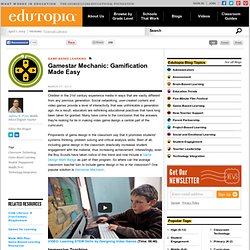

60 Educational Game Sites That You’ve Probably Never Seen. Gamestar Mechanic: Gamification Made Easy. Children in the 21st century experience media in ways that are vastly different from any previous generation.

Social networking, user-created content and video games provide a level of interactivity that was unthinkable a generation ago. As a result, educators are rethinking educational practices that have long been taken for granted. Many have come to the conclusion that the answers they're looking for lie in making video game design a central part of the curriculum. Proponents of game design in the classroom say that it promotes students' systems thinking, problem solving and critical analysis skills. Best of all, including game design in the classroom drastically increases student engagement with the material, thus increasing achievement. VIDEO: Learning STEM Skills by Designing Video Games (Time: 06:40) Immersive Teaching Gamestar Mechanic is a one-stop solution for teachers who see the potential of game design being included in their classroom, but may not know where to begin.
Game-Based Learning: Resource Roundup. Teaching Tools: Using Online Simulations and Games. Students who are passionate gamers can talk a blue streak about the virtual online worlds where they invest their free time and energy.

Usually, of course, they get to play only when they're not at school. But why not bring gaming into the classroom? Could teachers tap that same passion to spark learning? Gaming remains new territory for most schools. As the following examples show, educators on the frontiers are eager to share what they're learning. Evoke Social Change This spring, several teachers introduced their high school students to an alternate reality game that challenges players to solve big global challenges. Here's how it works: Each week, a new chapter from a graphic novel introduces players to a different challenge from the not-so-distant future.
Paul Allison, an English teacher at East-West School of International Studies in New York, has been playing Evoke right alongside his students. As Allison explains in this recent blog post: WoW and Tech Standards? What Can We Learn from Gaming? I have been thinking a lot recently about video gaming and what we can learn from it as educators.

This is not a new concept or a new discussion. I've been seeing things happen in my classroom that really make me think there's something to this idea. My recent reflections and changes in classroom practice don't actually involve my students playing games to learn new skills or concepts (though there is research about the positive effects of this), but rather on the broader structure of games in relation to classroom practices. For one, while watching my students play games I notice that they easily just click 'retry' or 'new game' or 'start over' and keep trying until they master whatever skill that game's level requires. They don't worry about making mistakes because they know they will get another chance. In addition, games provide immediate feedback.
Games also have a purpose, an underlying goal. How I turned my classroom into a 'living video game'—and saw achievement soar. By Joli Barker Read more by Contributor March 12th, 2013 In this innovative environment, students are active players in their own educational game.

The notion that struggling and failing is important to learning runs counter to traditional approaches to U.S. education. In fact, failure and its accompanying “F” grade stigmatizes a student as unprepared or “challenged” and is usually seen as a predictor of failure in future grades. In the world of gaming, however, the very elements of struggle, challenge, and failure that discourage kids in the classroom become the primary drivers of engagement and achievement. In 2011, after 14 years of teaching, I decided to transform my second grade classroom into a living video game. How to keep the attention of students is an ongoing topic of conversation among educators. I use QR codes and augmented reality codes to help students move independently from one activity to the next.
Hot Potatoes Home Page. 60 Educational Game Sites That You’ve Probably Never Seen « Tech:-)Happy. Printable crosswords with images or text hints, crossword puzzles to print for kids. Free Puzzlemaker. GameBuilder. Get Started Games Appeal to Your Students’ Need to Succeed Use electronic games to: Reinforce learning by having students quiz themselves on their own time.

Build excitement by having students cooperate or compete with each other as individuals or teams. Choose your game Choose from templates for many different games. You decide how long the game should be by the number of questions you enter. Students receive immediate feedback and can play the game as often as they wish. Click on Get Started to begin Begin by clicking on the Get Started link at the top of the page to see a list of directions.
Wisconsin Technical College System faculty and staff members have an unlimited account and do not need to purchase a subscription.